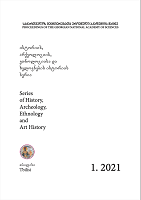ინსბრუკის ლანგარი, როგორც შუა საუკუნეების ქართული კულტურის ენციკლოპედია
INNSBRUCK PLATE – ENCYCLOPEDIA OF MEDIEVAL GEORGIAN CULTURE
Author(s): Beka ChichinadzeSubject(s): Archaeology, Cultural history, Visual Arts, Sociology of Culture, 6th to 12th Centuries, Sociology of Art, History of Art
Published by: საქართველოს მეცნიერებათა ეროვნული აკადემიის გამომცემლობა
Keywords: Innsbruck; Georgia; Plate; Alexander the Great; Enamel;
Summary/Abstract: In Innsbruck, Austria, is preserved a unique Medieval art artefact, an enamel-decorated plate. Its height - five Centimeters, Diameter - twenty-five Centimeters. Dark Red, Yellow, Green, Blue, Turquoise, Black and White Colors are used in his images. In the middle of the plate, a circle depicts a famous story, The Rise of Alexander the Great - the young man holds crossed sticks in his hands, surrounded by two birds. Around the circle containing image of Alexander, there are six other circles below the plate and six on the lower side and images of Peacocks, lions, as well as a wide variety of compositions: Snakes with Eagle claws, Winged Horses, Wrestlers, Dancers and Acrobats, Flute players, Birds and Trees of life. Inscription shows, that this plate received as a gift one of the Artuqid rulers - Amir Daud (1114-1142), the owner of Hisn Kaifa. According to some researchers, this product belongs to the Georgian school of enamel. Many images of plate are repeated on various monuments of Georgian art of this era. We have shown several cases, when various stories and plant motifs reflected on the plate, are repeated in the Georgian ecclesiastical art. In the Middle Ages, enamel products had a very high price, which is why this product was considered a suitable royal gift in Georgia. Georgian chronicles pay great attention to the royal gift and attach special importance to the ability to choose a worthy gift among the qualities necessary for the king. The Innsbruck plate also belongs to this tradition, as a magnificent monument of Medieval art, where many images from this era can be found, which, unlike ecclesiastical art, are not limited.
- Issue Year: 2021
- Issue No: 1
- Page Range: 194-208
- Page Count: 15
- Language: Georgian

